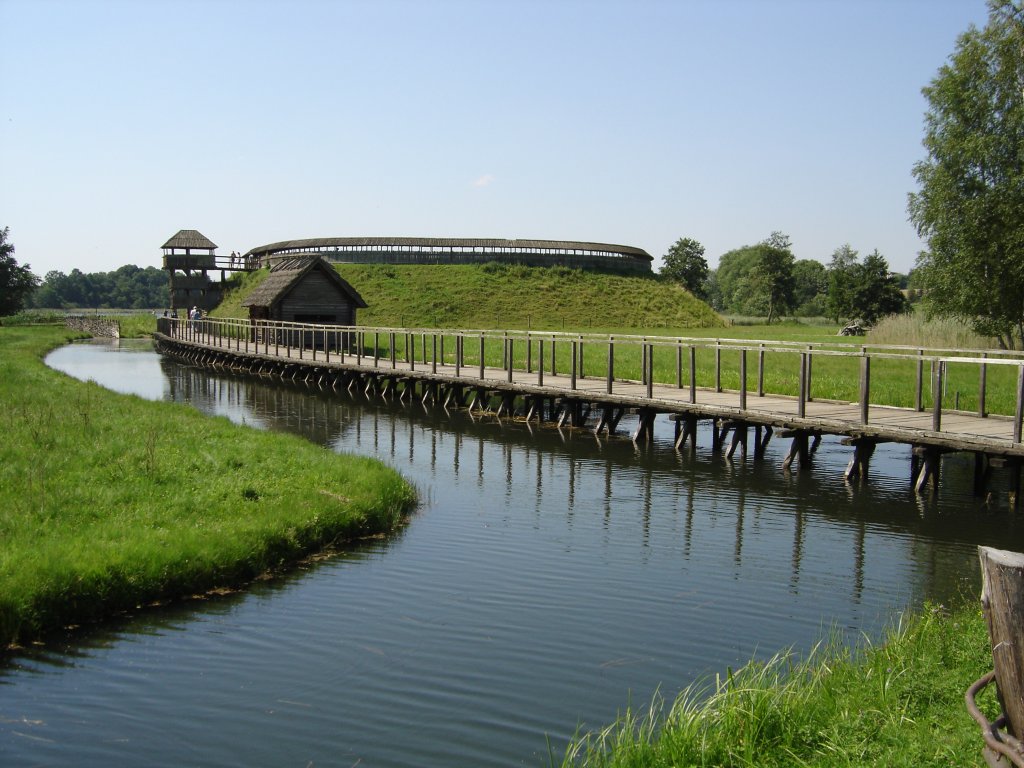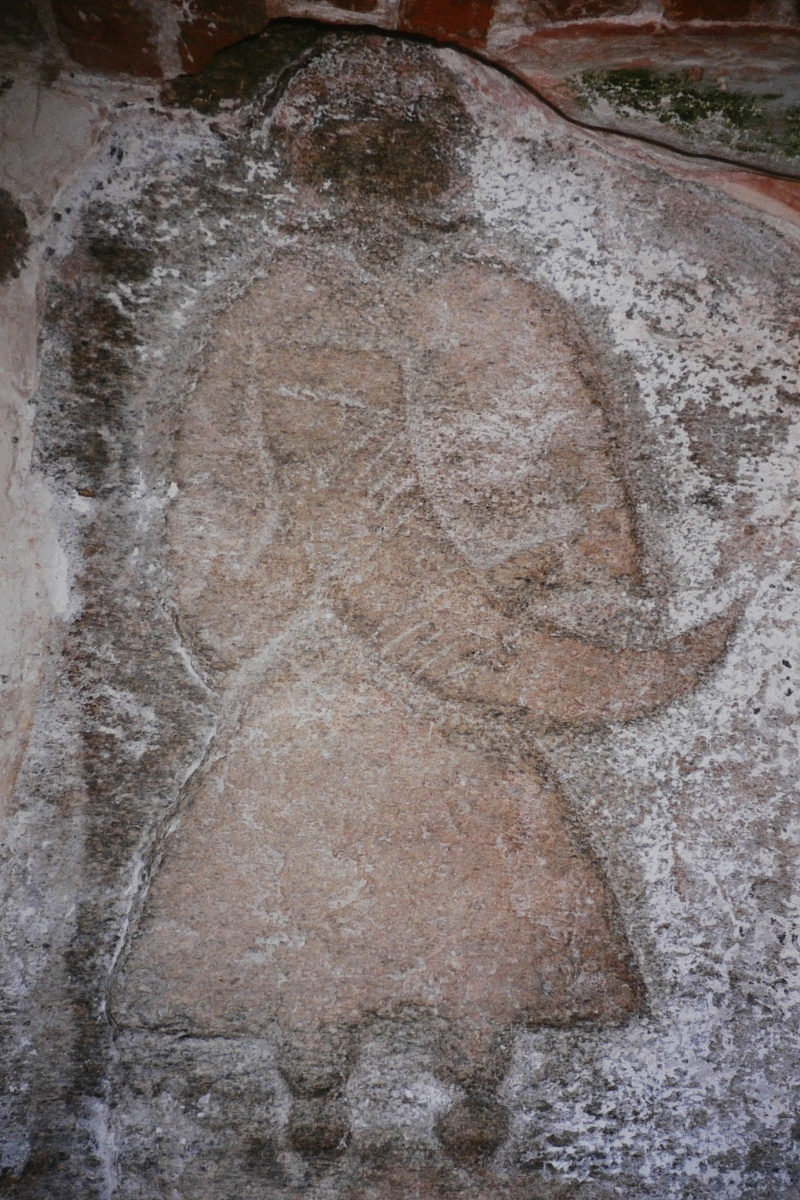|
Svantevit
Svetovit, Sventovit, Svantovit is the god of abundance and war, and the chief god of the Slavic tribe of the Rani, and later of all the Polabian Slavs. His organized cult was located on the island of Rügen, at Cape Arkona, where his main temple was also located. According to the descriptions of medieval chroniclers, the statue representing this god had four heads, a horn and a sword, and to the deity himself were dedicated a white horse, a saddle, a bit, a flag, and eagles. Once a year, after the harvest, a large festival was held in his honor. With the help of a horn and a horse belonging to the god, the priests carried out divinations, and at night the god himself rode a horse to fight his enemies. His name can be translated as "Strong Lord" or "Holy Lord". In the past it was often mistakenly believed that the cult of Svetovit originated from St. Vitus. Among scholars of Slavic mythology, Svetovit is often regarded as a Polabian hypostasis of Pan-Slavic god Perun. His cult ... [...More Info...] [...Related Items...] OR: [Wikipedia] [Google] [Baidu] |
Rani (Slavic Tribe)
The Rani or Rujani (german: Ranen, ''Rujanen'') were a West Slavic tribe based on the island of Rugia (Rügen) and the southwestern mainland across the Strelasund in what is today northeastern Germany. The Rani tribe emerged after the Slavic settlement of the region in the ninth century,Ole Harck, Christian Lübke, Zwischen Reric und Bornhöved: Die Beziehungen zwischen den Dänen und ihren slawischen Nachbarn vom 9. Bis ins 13. Jahrhundert: Beiträge einer internationalen Konferenz, Leipzig, 4.-6. Dezember 1997, Franz Steiner Verlag, 2001, p.15, and ranked among the most powerful of several small Slav tribes between the Elbe and lower Vistula rivers before the thirteenth century. They were among the last tribes to hold to Slavic paganism, and the influence of their religious center at Arkona reached far beyond their tribal borders. In 1168, the Rani were defeated by King Valdemar I of Denmark, and his adviser Absalon, Bishop of Roskilde, resulting in the conversion of ... [...More Info...] [...Related Items...] OR: [Wikipedia] [Google] [Baidu] |
Cape Arkona
Cape Arkona () is a 45-metre (150-foot) high cape on the island of Rügen in Mecklenburg-Vorpommern, Germany. It forms the tip of the Wittow peninsula, just a few kilometres north of the Jasmund National Park. The protected landscape of Cape Arkona, together with the fishing village of Vitt, belongs to the municipality of Putgarten and is one of the most popular tourist destinations on Rügen, receiving about 800,000 visitors annually. On the cape there are two lighthouses, a navigation tower, two military bunker complexes, the Slavic temple fortress of ''Jaromarsburg'' and several tourist buildings (restaurants, pubs and souvenir shops). Because of its geology and the weathering that occurs here, there are frequent coastal collapses, especially in winter. Cape Arkona is often referred to as "the northernmost point of Rügen", which is not true. Approximately one kilometre to the north-west, there is a point on the steep coast, known as the ''Gellort'', which is a little f ... [...More Info...] [...Related Items...] OR: [Wikipedia] [Google] [Baidu] |
Polabian Slavs
Polabian Slavs ( dsb, Połobske słowjany, pl, Słowianie połabscy, cz, Polabští slované) is a collective term applied to a number of Lechitic ( West Slavic) tribes who lived scattered along the Elbe river in what is today eastern Germany. The approximate territory stretched from the Baltic Sea in the north, the Saale and the '' Limes Saxoniae''Christiansen, 18 in the west, the Ore Mountains and the Western Sudetes in the south, and Poland in the east. They have also been known as Elbe Slavs (german: Elbslawen) or Wends. Their name derives from the Slavic ''po'', meaning "by/next to/along", and the Slavic name for the ''Elbe'' (''Labe'' in Czech and ''Łaba'' in Polish). The Polabian Slavs started settling in the territory of modern Germany in the 6th century. They were largely conquered by Saxons and Danes since the 9th century and were subsequently included and gradually assimilated within the Holy Roman Empire. The tribes were gradually Germanized and assimilate ... [...More Info...] [...Related Items...] OR: [Wikipedia] [Google] [Baidu] |
Polabian Religion
Slavic mythology or Slavic religion is the Religion, religious beliefs, myths, and ritual practices of the Slavs before Christianisation of the Slavs, Christianisation, which occurred at various stages between the 8th and the 13th century. The South Slavs, who likely settled in the Balkan Peninsula during the 6th–7th centuries AD, bordering with the Byzantine Empire to the south, came under the sphere of influence of Eastern Christianity, beginning with the creation of writing systems for Slavic languages (first Glagolitic, and then Cyrillic script) in 855 by the brothers Saints Cyril and Methodius and the adoption of Christianity in Bulgaria in 863. The East Slavs followed with the official adoption in 988 by Vladimir the Great of Kievan Rus'. The West Slavs, West Slavs' process of Christianization was more gradual and complicated. The Moravians accepted Christianity as early as 831, the Bohemian dukes followed in 845, Slovaks accepted Christianity somewhere between the years 8 ... [...More Info...] [...Related Items...] OR: [Wikipedia] [Google] [Baidu] |
Nasal Vowel
A nasal vowel is a vowel that is produced with a lowering of the soft palate (or velum) so that the air flow escapes through the nose and the mouth simultaneously, as in the French vowel or Amoy []. By contrast, oral vowels are produced without nasalization. Nasalized vowels are vowels under the influence of neighbouring sounds. For instance, the [] of the word ''hand'' is affected by the following nasal consonant. In most languages, vowels adjacent to nasal consonants are produced partially or fully with a lowered velum in a natural process of assimilation and are therefore technically nasal, but few speakers would notice. That is the case in English: vowels preceding nasal consonants are nasalized, but there is no phonemic distinction between nasal and oral vowels, and all vowels are considered phonemically oral. The nasality of nasal vowels, however, is a distinctive feature of certain languages. In other words, a language may contrast oral vowels and nasalized vowels p ... [...More Info...] [...Related Items...] OR: [Wikipedia] [Google] [Baidu] |
Polabian Language
The Polabian language was a West Slavic language that was spoken by the Polabian Slavs (german: Wenden) in present-day northeastern Germany around the Elbe (''Łaba/Laba/Labe'' in Slavic) river, from which derives its name ("po Labe" – ''unto Elbe'' or ''ravelingon Elbe''). It was spoken approximately until the rise to power of Prussia in the mid-18th century – when it was superseded by Low German – in the areas of Pomoré (Mecklenburg-West Pomerania), central ( Mittelmark) part of Branibor (Brandenburg) and eastern Saxony-Anhalt (Wittenberg originally part of Béla Serbia), as well as in eastern parts of Wendland (Lower Saxony) and Dravänia (Schleswig-Holstein), Ostholstein and Lauenburg). Polabian was also relatively long (until the 16th century) spoken in and around the cities of Bukovéc (Lübeck), Starigard (Oldenburg) and Trava (Hamburg). The very poorly attested Slavic dialects of Rügen seemed to have had more in common with Polabian than with Pomeranian ... [...More Info...] [...Related Items...] OR: [Wikipedia] [Google] [Baidu] |
Proto-Slavic Language
Proto-Slavic (abbreviated PSl., PS.; also called Common Slavic or Common Slavonic) is the unattested, reconstructed proto-language of all Slavic languages. It represents Slavic speech approximately from the 2nd millennium B.C. through the 6th century A.D. As with most other proto-languages, no attested writings have been found; scholars have reconstructed the language by applying the comparative method to all the attested Slavic languages and by taking into account other Indo-European languages. Rapid development of Slavic speech occurred during the Proto-Slavic period, coinciding with the massive expansion of the Slavic-speaking area. Dialectal differentiation occurred early on during this period, but overall linguistic unity and mutual intelligibility continued for several centuries, into the 10th century or later. During this period, many sound changes diffused across the entire area, often uniformly. This makes it inconvenient to maintain the traditional definition of a pr ... [...More Info...] [...Related Items...] OR: [Wikipedia] [Google] [Baidu] |
Zbruch Idol
The Zbruch Idol, Sviatovid (''Worldseer'', pl, Światowid ze Zbrucza, uk, Збручанський ідол) is a 9th-century sculpture, more precisely an example of a bałwan, and one of the few monuments of pre-Christian Slavic beliefs (according to another interpretation, it was created by the Kipchaks/Cumans). The pillar was commonly incorrectly associated with the Slavic deity Sviatovid, although current opinions on the exact meaning of all the bas-reliefs and their symbols differ. It is thought that the three tiers of bas-relief represent the three levels of the world, from the bottom underworld, to the middle mortal world and the uppermost, largest, world of heavenly gods. It is suggested that the sculpture was disposed of or was buried in a pit some time after the baptism of Kyivan Rus, and acceptance of Christianity in Poland in 966, like various buried idols in Kyiv and Novgorod. In the 19th century, when the Zbruch River (a left tributary of the Dniester) changed ... [...More Info...] [...Related Items...] OR: [Wikipedia] [Google] [Baidu] |
Polish Alphabet
The Polish alphabet ( Polish: ''alfabet polski'', ''abecadło'') is the script of the Polish language, the basis for the Polish system of orthography. It is based on the Latin alphabet but includes certain letters with diacritics: the ''kreska'', or acute accent (''ć'', ''ń'', ''ó'', ''ś'', ''ź''); the overdot, or ''kropka'' (''ż''); the tail, or ''ogonek'' (''ą'', ''ę''); and the stroke (''ł''). The letters ''q'', ''v'', and ''x'', which are used only in foreign words, are usually absent from the Polish alphabet. However, prior to the standardization of the Polish language, the letter "x" was sometimes used in place of "ks". Modified variations of the Polish alphabet are used for writing Silesian and Kashubian, whereas the Sorbian languages use a mixture of the Polish and Czech orthographies. Letters There are 32 letters in the Polish alphabet: 9 vowels and 23 consonants. The letters ''q'', ''v'', and ''x'' are not used in any native Polish words and are mostly f ... [...More Info...] [...Related Items...] OR: [Wikipedia] [Google] [Baidu] |
Digraph (orthography)
A digraph or digram (from the grc, δίς , "double" and , "to write") is a pair of characters used in the orthography of a language to write either a single phoneme (distinct sound), or a sequence of phonemes that does not correspond to the normal values of the two characters combined. Some digraphs represent phonemes that cannot be represented with a single character in the writing system of a language, like the English '' sh'' in ''ship'' and ''fish''. Other digraphs represent phonemes that can also be represented by single characters. A digraph that shares its pronunciation with a single character may be a relic from an earlier period of the language when the digraph had a different pronunciation, or may represent a distinction that is made only in certain dialects, like the English '' wh''. Some such digraphs are used for purely etymological reasons, like '' rh'' in English. Digraphs are used in some Romanization schemes, like the '' zh'' often used to represent t ... [...More Info...] [...Related Items...] OR: [Wikipedia] [Google] [Baidu] |
Polish Language
Polish (Polish: ''język polski'', , ''polszczyzna'' or simply ''polski'', ) is a West Slavic language of the Lechitic group written in the Latin script. It is spoken primarily in Poland and serves as the native language of the Poles. In addition to being the official language of Poland, it is also used by the Polish diaspora. There are over 50 million Polish speakers around the world. It ranks as the sixth most-spoken among languages of the European Union. Polish is subdivided into regional dialects and maintains strict T–V distinction pronouns, honorifics, and various forms of formalities when addressing individuals. The traditional 32-letter Polish alphabet has nine additions (''ą'', ''ć'', ''ę'', ''ł'', ''ń'', ''ó'', ''ś'', ''ź'', ''ż'') to the letters of the basic 26-letter Latin alphabet, while removing three (x, q, v). Those three letters are at times included in an extended 35-letter alphabet, although they are not used in native words. The traditiona ... [...More Info...] [...Related Items...] OR: [Wikipedia] [Google] [Baidu] |






